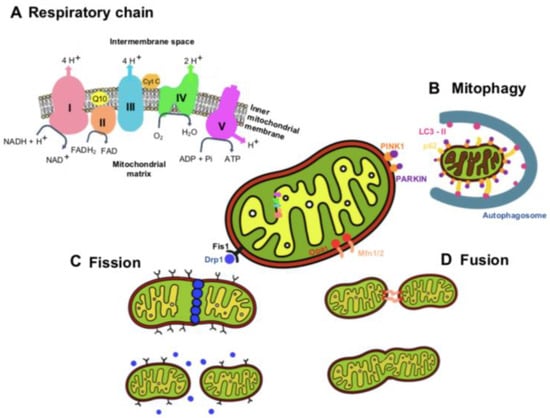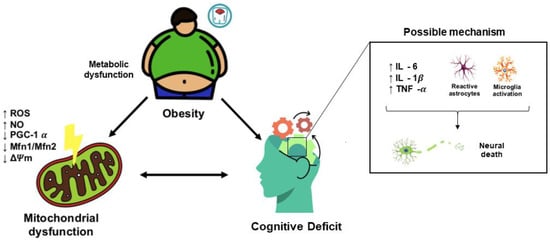Obesity is defined as abnormal and excessive fat accumulation, and it is a risk factor for developing metabolic and neurodegenerative diseases and cognitive deficits. Obesity is caused by an imbalance in energy homeostasis resulting from increased caloric intake associated with a sedentary lifestyle. However, the entire physiopathology linking obesity with neurodegeneration and cognitive decline has not yet been elucidated. During the progression of obesity, adipose tissue undergoes immune, metabolic, and functional changes that induce chronic low-grade inflammation. It has been proposed that inflammatory processes may participate in both the peripheral disorders and brain disorders associated with obesity, including the development of cognitive deficits. In addition, mitochondrial dysfunction is related to inflammation and oxidative stress, causing cellular oxidative damage.
- high-fat diets
- cognitive decline
- metabolic disorders
- energy homeostasis
- neuroinflammation
- mitochondria
- hippocampus
- hypothalamus
1. Introduction
2. Mitochondria Functions and Dynamics
Mitochondria are double-membrane organelles responsible for energy production and homeostasis, the regulation of intracellular calcium levels, and the regulation of apoptosis (mainly via the intrinsic pathway) [17][18][17,18]. In addition, mitochondria are responsible for generating more than 90% of the energy for the cell through oxidative phosphorylation [19][20][19,20]. To generate ATP through oxidative phosphorylation, mitochondria use an electron transport chain inserted within the mitochondrion’s inner membrane (Figure 1) [21]. NADH and FADH2 are generated by the Krebs cycle and donate electrons to complex I (NADH: ubiquinone oxidoreductase) and complex II (succinate dehydrogenase), respectively. The electrons from NADH are passed from complex I to ubiquinone (CoQ) in order to enter the Q cycle, where CoQ is reduced to ubiquinol (QH2). This electron transfer induces the pumping of protons by complex I from the matrix into the intermembrane space. The electrons donated from FADH2 are transferred from complex II to CoQ similarly to complex I, although this process is not accompanied by proton translocation [21]. Once in the Q cycle, the electrons are transferred to complex III (coenzyme Q: cytochrome c reductase) and then to cytochrome c, releasing two protons into the intermembrane space. Then, when cytochrome c is reduced, it transports single electrons from complex III to complex IV (cytochrome c oxidase), where molecular oxygen is reduced to water. At complex IV, a total of eight protons are pumped from the matrix, of which four are used to form two water molecules, and the other four are transferred into the intermembrane space [21][22][21,22].
3. Obesity Induces Cognitive Decline
Obesity, as well as HFD diet consumption, and metabolic disorders, such as diabetes mellitus, are widely recognized as inducing impairments in brain structure and function in the form of memory dysfunction, as well as neurodegenerative diseases [37]. Furthermore, magnetic resonance imaging studies have demonstrated that regional brain atrophy and changes in gray and white matter are observed in patients with obesity, providing new insights into the relationship between obesity and cognitive decline from the imaging perspective [37][38][39][40][37,38,39,40]. Furthermore, a higher BMI is correlated with a lower gray matter volume in the prefrontal, temporal, insular, and occipital cortexes; thalamus; putamen; amygdala; and cerebellum, mediating the negative effects on memory performance [41]. Patients with obesity have an earlier onset of Alzheimer’s, which is considered an aging disease [42]. An 18-year follow-up longitudinal study demonstrated a higher degree of overweight in older women who developed AD. No associations were found in men [42]. In the same study, the authors concluded that Alzheimer’s disease risk increased by 36% for every 1.0 increase in BMI. In other studies, it has been shown that patients with a higher BMI present significantly lower scores in cognitive tests and a longitudinal decline in cognitive abilities in both men and women [37][43][44][37,43,44]. Changes in cognitive function can be potentiated since middle-aged adults with obesity may experience differentially greater brain atrophy [37]. The relationship between a higher BMI and reduced cognitive performance does not change with age [45] or race [46]. A high intake of fat and sugar is associated with impairments in hippocampal-dependent learning and memory in children [47] and adults [48][49][48,49], suggesting a negative impact on hippocampal function across the lifespan. In the community-based Framingham Offspring Cohort, it was observed that central obesity was significantly related to poorer performance in executive function and visuomotor skills, and no changes were observed for verbal memory [50]. Adults with overweight and obesity also have poorer executive function than normal-weight adults, without changes in performance on attention tests. Children and adolescents with overweight/obesity also present poor cognitive function on verbal, full-scale, and performance IQ; visual–spatial; and executive function tests [51][52][51,52]. A systemic review found that executive dysfunction is associated with obesity-related behaviors in children and adolescents, such as increased food intake, disinhibited eating, and less physical activity. In children and adolescents, obesity is associated with poorer cognitive competence and may affect their academic achievements [53]. Body weight and diet composition are modified risk factors for cognitive decline. Weight loss appears to be associated with low-order improvements in executive/attention functioning and memory in individuals with obesity. Moreover, a stable BMI predicts better cognitive trajectories [54]. Patients with severe obesity may obtain immediate verbal and delayed memory function benefits from Roux-en-Y gastric bypass [55][56][55,56]. Different animal models of obesity and metabolic disorders have also exhibited cognitive dysfunctions and worse performance in learning and memory tasks compared to non-obese animals [57][58][59][60][61][62][57,58,59,60,61,62]. In addition, based on studies of animal models and in vitro models, high levels of glucose and saturated fatty acids are responsible for neuroinflammation, microglia activation, mitochondrial dysfunction, neuronal loss, and impairments in synaptic plasticity (Figure 2) [63][64][65][66][67][68][63,64,65,66,67,68].
